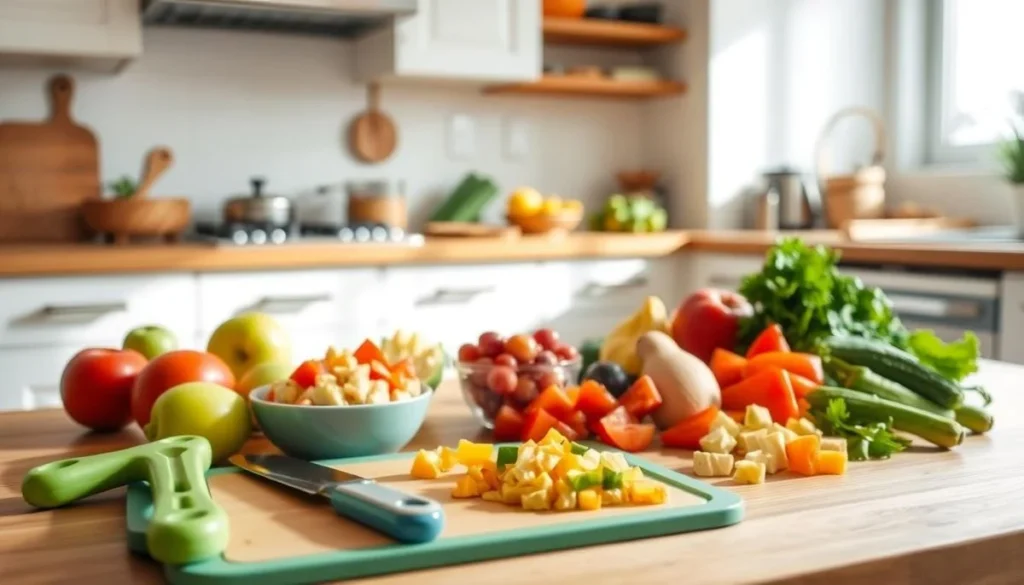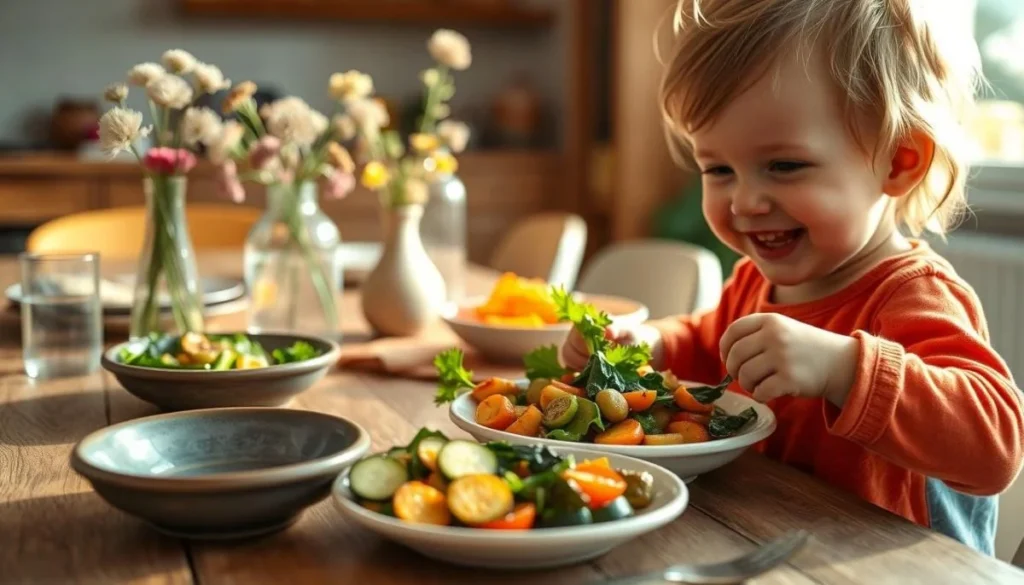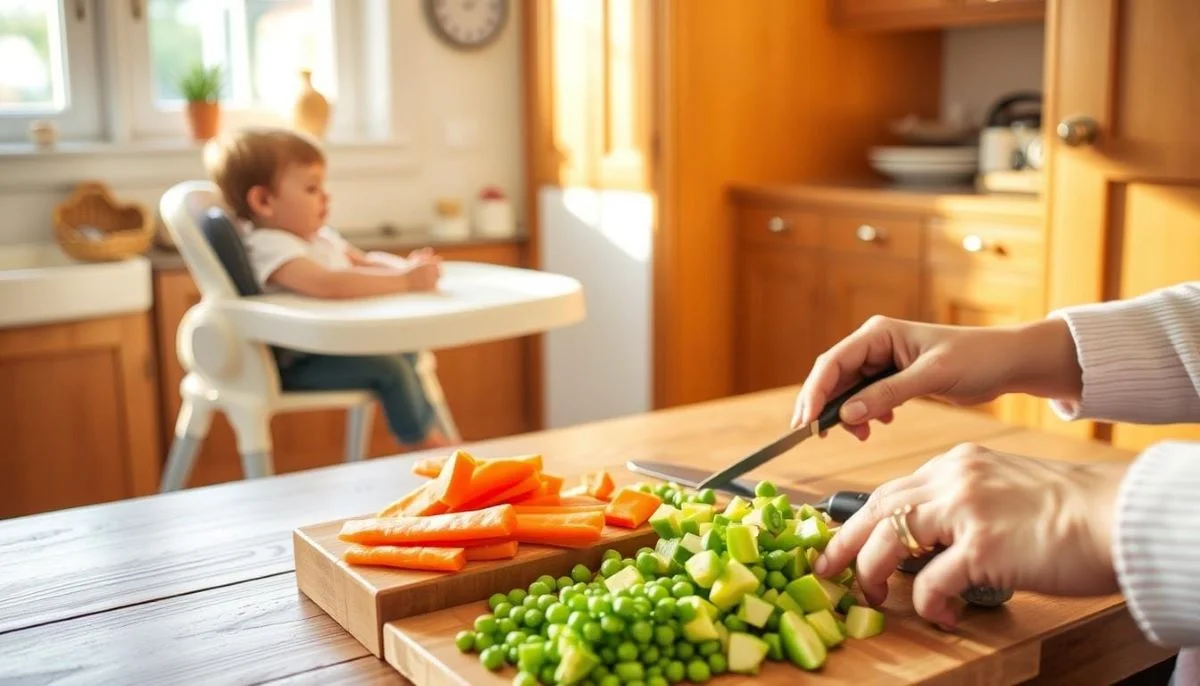Quick & Easy Dinners for 1 Year Old Toddlers
Parenthood is a wild journey of love, discovery, and countless meal times. As your little one grows from baby to toddler, dinners become a fun challenge. They mix nutrition with creativity.
The world of toddler meals is complex. One moment they love a dish, the next they push it away. It’s a normal part of their growth.
Navigating dinners for 1 year old children requires patience and strategy. Their appetite changes a lot during this stage. Many parents find their child eats less than they did as infants, which is normal.
Toddler meals are more than just filling tiny tummies. They’re about introducing new flavors, textures, and nutrients. Quick baby food recipes can turn dinner into a fun adventure.
Every toddler is unique. Some will eat everything, while others are pickier. Your approach should be flexible, creative, and stress-free.
In the upcoming sections, we’ll explore practical strategies for preparing delicious, nutritious dinners. These will make both you and your toddler smile. From one-pot wonders to hidden vegetable tricks, get ready to change your family’s mealtime experience.
Understanding Your One-Year-Old’s Nutritional Needs
Figuring out what to feed your toddler can be tough. They grow fast and need healthy meals for their health.
Your child needs a mix of nutrients for growth and brain development. The American Academy of Pediatrics suggests a careful feeding plan for the best nutrition.
Essential Nutrients for Toddler Development
Your toddler needs different nutrients for growth. Here are the main ones for protein-rich meals:
- Protein for muscle growth
- Healthy fats for brain growth
- Iron for brain function
- Calcium for strong bones
Portion Sizes and Feeding Frequency
One-year-olds need 700 to 1000 calories a day. They should eat:
- Three main meals
- Two healthy snacks
- About 16 ounces of whole milk
Pro tip: Each meal should have about 140 calories for balanced nutrition all day.
Signs of Hunger and Fullness
It’s key to know when your toddler is hungry or full. Look for signs like wanting food, turning away, or getting upset. This helps you meet their needs and avoid overfeeding.
Remember, every child is unique, and their nutritional needs can vary.
Best Dinner Time Practices for Toddlers
Creating a positive mealtime experience is key for your one-year-old’s nutrition and growth. Easy toddler dinner ideas can turn mealtime into a fun family activity. Consistent dinner practices help your child develop good eating habits and social skills.
Successful dinner times involve several key strategies:
- Offer finger foods for 1 year olds to encourage self-feeding skills
- Create a relaxed dining environment
- Make meals visually appealing
- Involve your toddler in meal preparation
Portion sizes are important when planning meals. A one-year-old usually needs 1/4 to 1/2 of an adult’s portion. This prevents overwhelming your child and cuts down on food waste. Try making colorful, bite-sized meals that are easy for your child to handle.
| Dinner Time Strategy | Benefits |
|---|---|
| Family Meals | Promotes social learning and bonding |
| Consistent Schedules | Helps establish routine and expectations |
| Varied Textures | Develops sensory skills and food acceptance |
Remember, picky eating is normal at this age. Experts say it may take 10-15 tries before a child tries a new food. Stay patient and keep offering a variety of nutritious options during dinner.
“Mealtime is about more than just nutrition – it’s an opportunity for learning and connection.”
Kitchen Safety and Food Preparation Guidelines
Preparing healthy meals for toddlers needs careful attention to safety and nutrition. When making baby food, focus on making it tasty and safe for your child.

When cooking for a one-year-old, there are important safety steps to follow. These steps help avoid health risks.
Safe Food Sizes and Textures
Cutting food into the right sizes is key to avoid choking. Here are some important guidelines for safe food preparation:
- Cut foods into small, bite-sized pieces no larger than 1/2 inch
- Avoid round, hard foods that can block airways
- Cook vegetables until they are soft and easily mashed
- Remove seeds and tough skins from fruits and vegetables
Temperature Guidelines
Keeping food at the right temperature is important for safety and enjoyment:
| Food Type | Safe Temperature | Cooling Time |
|---|---|---|
| Hot Meals | Under 110°F | 5-10 minutes |
| Refrigerated Foods | 40°F or below | N/A |
| Frozen Foods | Thoroughly heated | Let cool before serving |
Common Choking Hazards to Avoid
Some foods are dangerous for toddlers and should be avoided or modified:
- Whole grapes
- Nuts and large seeds
- Hard candies
- Popcorn
- Chunks of raw vegetables
- Hot dogs
Always watch your child during meals and cut food into safe sizes. This care can prevent choking and make mealtime fun for everyone.
Simple Dinners for 1 Year Old That Take 15 Minutes
Preparing quick and nutritious dinners for 1 year olds is a big help for busy parents. You don’t need to make complicated meals. With smart strategies, you can make tasty meals that everyone will love.
- Cheese Quesadillas: A protein-packed option ready in under 5 minutes
- 2-Ingredient Pancakes: Simple and nutritious
- Nut Butter and Jelly Sandwiches: Quick and kid-friendly
- Canned Soup with Added Vegetables: Convenient and balanced
When making dinners for 1 year olds, aim to include different food groups. Variety is key to ensuring your child receives essential nutrients.
“The best meals are those that are quick, nutritious, and enjoyable for both parent and child.” – Pediatric Nutrition Expert
| Meal Type | Preparation Time | Nutritional Benefits |
|---|---|---|
| Cheese Quesadillas | 5 minutes | Protein, Calcium |
| Egg Scramble with Veggies | 10 minutes | Protein, Vitamins |
| Mini Pita Pizza | 15 minutes | Whole Grains, Vegetables |
Easy toddler dinner ideas should be simple, healthy, and fit your child’s tastes. Don’t worry about making fancy meals. Focus on meals that are balanced and fun to eat.
Healthy Protein Options for Growing Toddlers
Protein is key for your toddler’s growth. The American Academy of Pediatrics says kids aged 1 to 3 need two protein servings a day. Knowing the best protein sources helps make meals that meet their nutritional needs.
Protein is vital for muscles, immune health, and growth. Toddlers can get protein from many tasty and healthy foods.
Meat and Fish Choices
Lean meats and fish are great protein options for toddlers. Here are some good choices:
- Chicken strips cut into small pieces
- Ground turkey meatballs
- Salmon pieces (limited to 2 ounces per week)
- Soft, shredded beef
Plant-Based Protein Ideas for Vegetarian Toddler Dinners
Vegetarian meals can be full of protein from plants. Check out these healthy options:
- Tofu cubes (17g protein per 3.5oz)
- Beans and lentils
- Nut butters (3.6g protein per tablespoon)
- Quinoa
Dairy-Based Protein Sources
Dairy is another good source of protein for toddlers:
- Greek yogurt
- Cheese cubes
- Cottage cheese
Pro Tip: Introduce protein-rich foods gradually and watch for any potential allergic reactions.
Most toddlers get enough protein from a balanced diet. Always talk to your pediatrician about your child’s nutritional needs.
Vegetable-Rich Dinner Ideas That Toddlers Love

Getting your toddler to eat veggies can be tough. But, with fun and healthy meals, you can make it exciting. Recipes that mix veggies into baby food can turn mealtime into a fun experience.
Here are some veggie-packed options that your little one will love:
- Sweet Potato & Zucchini Nuggets: A kid-friendly recipe using just 4 ingredients that provides essential nutrients
- Cheesy Corn and Zucchini Fritters: Budget-friendly and packed with vegetables
- Veggie-Loaded Macaroni Frittata: Combining eggs, cheese, and assorted vegetables
When making baby food, think about these veggie superstars:
- Spinach: Rich in iron, vitamin B6, and fiber
- Broccoli: Contains anti-inflammatory properties
- Sweet Potatoes: Excellent for blood sugar regulation
- Bell Peppers: Loaded with cancer-fighting antioxidants
For healthy toddler dinners, wash veggies well, cook them until soft, and make them look good. Most kids eat veggies, so don’t worry if it takes time.
Pro tip: Involve your toddler in meal preparation to increase their interest in vegetables!
Remember, variety and creativity are key to getting your child to eat more veggies.
Make-Ahead Meals and Batch Cooking Tips
Streamlining meal prep for toddlers can change your daily cooking routine. Batch cooking is a smart way for busy parents. It saves time and reduces stress.
Preparing meals ahead means you have healthy dinners ready when your toddler is hungry. The trick is to plan well and use smart ways to preserve food.
Freezer-Friendly Options
Freezer meals are a big help for parents. You can cook many meals at once. This makes meal prep for toddlers very efficient.
- Homemade chicken nuggets
- Mini egg muffins
- Broccoli tots
- One-pot mac and cheese
Storage Guidelines
Proper storage keeps your toddler’s meals safe and tasty. Here are key tips for freezing:
| Food Type | Freezer Storage Duration | Recommended Storage Method |
|---|---|---|
| Cooked Meals | Up to 3 months | Airtight containers |
| Soups/Stews | Up to 6 months | Freezer bags |
| Meatballs/Nuggets | Up to 3 months | Single-layer freezing |
Reheating Instructions
It’s important to reheat frozen meals safely. Always thaw meals in the refrigerator. Use methods like:
- Microwave with stirring
- Oven at low temperature
- Air fryer for crispy textures
Your meal prep strategy can make dinnertime easy and stress-free. You’ll have nutritious and tasty meals that you and your child will enjoy.
Common Feeding Challenges and Solutions
Feeding a 1-year-old can be like solving a puzzle. Their eating habits might seem unpredictable. But, knowing common challenges can make mealtime easier.
Picky eating is common for toddlers. Research says children need to taste a new food between 8 and 15 times before accepting it. So, don’t worry if your toddler doesn’t like new foods at first.
“Kids can learn to eat well, similar to learning to read, but the process requires time and patience.”
Here are some tips for handling feeding challenges:
- Serve very small portions of new foods
- Offer consistent exposure to fruits and vegetables
- Create positive mealtime environments
- Avoid pressuring your toddler to eat
Appetite changes are normal. When your toddler is sick, give them foods they can handle. Some kids might have food intolerances, with up to 8% having food allergies.
Every child is different. Your approach to feeding should be flexible, patient, and consistent. Keeping a calm attitude towards food helps your child develop good eating habits.
Get picks related to this post:
- Tasty Meals Toddlers and Preschoolers Love to Eat
- Healthy Meal Ideas for 14 Month Old | Toddler Nutrition
- Healthy Meals for 1 Year Old: Complete Feeding Guide
- 5-Minute Toddler Meals: Healthy & Satisfying Recipes
Conclusion
Creating healthy meals for toddlers is more than a daily task. It’s a chance to help your child grow and learn good eating habits. By making nutritious dinners, you play a big role in their development and how they see food.
Every child is different, and what works for one might not work for another. Being patient and creative is important when trying new foods. The aim is to offer balanced, fun, and healthy meals that meet your child’s needs.
Keep being flexible and watch for changes in your toddler’s tastes and needs. Getting advice from pediatric nutrition experts can help make sure your child gets the best nutrition. This is especially important in their early years of growth.
Your effort to make healthy meals shows your love and care for your toddler’s health. Enjoy the journey, the messy moments, and every small win at dinner time.
If you want to know about Toddler nutrition visit this link.
FAQ
How much food should a 1-year-old eat at dinner?
What are the best protein sources for toddlers?
How can I prevent choking when feeding my toddler?
What should I do if my toddler is a picky eater?
How can I incorporate more vegetables into my toddler’s diet?
Can I prepare toddler meals in advance?
What are some safe finger foods for 1-year-olds?
How do I know if my toddler is getting enough nutrition?
Are there vegetarian protein options for toddlers?
How can I make mealtime less stressful?
How did you find our Post?
There are no reviews yet. Be the first one to write one.

